Finite Element Analysis of Crack Propagation in Adhesive Joints with Notched Adherends
Abstract
:1. Introduction
2. Model Description
2.1. DCB with Notched Adherends
2.2. Finite Element Modeling Details
2.3. Performance Metrics
3. Results and Discussion
3.1. Mechanics of Crack Growth (Elastic Analysis)
3.2. Energy Breakdown
3.3. Apparent Fracture Toughness
3.4. Effect of Substrates Plasticity
3.4.1. Analysis of Applied Load and Crack Growth as a Function of the Opening Displacement
3.4.2. Effect of Notch Spacing and Geometry
4. Closing Remarks and Conclusions
Author Contributions
Funding
Data Availability Statement
Conflicts of Interest
Abbreviations
| FE | finite element |
| SLJ | single lap joint |
| DCB | double cantilever beam |
| VCCT | virtual crack closure technique |
| CZM | cohesive zone model |
| B | width of the specimen |
| H | thickness of the adherend |
| thickness of the adhesive layer | |
| total length of the specimen | |
| w | notch width |
| h | notch depth |
| notch spacing | |
| notch-free portion of the bondline (from initial crack tip) | |
| L | notched portion of the bondline |
| p | number of notches |
| initial crack length | |
| crack increment | |
| crack speed | |
| E | Young’s modulus |
| Poisson’s ratio | |
| yield strength | |
| tangential modulus | |
| ultimate strength | |
| fracture process zone | |
| length of | |
| opening traction in cohesive zone | |
| conjugated opening displacement | |
| initial stiffness of the cohesive model | |
| cohesive fracture energy | |
| cohesive strength | |
| final opening displacement | |
| viscous coefficient | |
| effective fracture energy | |
| apparent toughness | |
| external work | |
| fracture energy | |
| strain energy | |
| kinetic energy | |
| performance metric |
References
- Brooke, L. Honda Civic Hatchback Enjoys Premium Assembly, Weight-Cutting Measures. SAE Mobility Engineering, August 26th 2022, SAE Media Group. Available online: https://www.mobilityengineeringtech.com (accessed on 11 October 2022).
- Yudhanto, A.; Alfano, M.; Lubineau, G. Surface preparation strategies in secondary bonded thermoset-based composite materials: A review. Compos. Part A Appl. Sci. Manuf. 2021, 147, 106443. [Google Scholar] [CrossRef]
- Frascio, M.; Mandolfino, C.; Moroni, F.; Jilich, M.; Lagazzo, A.; Pizzorni, M.; Bergonzi, L.; Morano, C.; Alfano, M.; Avalle, M. Appraisal of surface preparation in adhesive bonding of additive manufactured substrates. Int. J. Adhes. Adhes. 2021, 106, 102802. [Google Scholar] [CrossRef]
- Alfano, M.; Pini, S.; Chiodo, G.; Barberio, M.; Pirondi, A.; Furgiuele, F.; Groppetti, R. Surface patterning of metal substrates through low power laser ablation for enhanced adhesive bonding. J. Adhes. 2014, 90, 384–400. [Google Scholar] [CrossRef]
- Moroni, F.; Musiari, F.; Favi, C. Influence of the laser ablation surface pre-treatment over the ageing resistance of metallic adhesively bonded joints. Int. J. Adhes. Adhes. 2021, 105, 102764. [Google Scholar] [CrossRef]
- Prolongo, S.G.; Horcajo, K.F.; Del Rosario, G.; Ureña, A. Strength and durability of epoxy-aluminum joints. J. Adhes. 2010, 86, 409–429. [Google Scholar] [CrossRef]
- Quan, D.; Murphy, N.; Ivankovic, A. Fracture behaviour of a rubber nano-modified structural epoxy adhesive: Bond gap effects and fracture damage zone. Int. J. Adhes. Adhes. 2017, 77, 138–150. [Google Scholar] [CrossRef]
- Sun, Z.; Shi, S.; Hu, X.; Guo, X.; Chen, J.; Chen, H. Short-aramid-fiber toughening of epoxy adhesive joint between carbon fiber composites and metal substrates with different surface morphology. Compos. Part B Eng. 2015, 77, 3444. [Google Scholar] [CrossRef]
- Tao, R.; Li, X.; Yudhanto, A.; Alfano, M.; Lubineau, G. Toughening adhesive joints through crack path engineering using integrated polyamide wires. Compos. Part A Appl. Sci. Manuf. 2022, 158, 106954. [Google Scholar] [CrossRef]
- Yudhanto, A.; Almulhim, M.; Kamal, F.; Tao, R.; Fatta, L.; Alfano, M.; Lubineau, G. Enhancement of fracture toughness in secondary bonded CFRP using hybrid thermoplastic/thermoset bondline architecture. Compos. Sci. Technol. 2020, 199, 108346. [Google Scholar] [CrossRef]
- Cordisco, F.A.; Zavattieri, P.D.; Hector, L.G., Jr.; Carlson, B.E. Mode I fracture along adhesively bonded sinusoidal interfaces. Int. J. Solids Struct. 2016, 83, 45–64. [Google Scholar] [CrossRef]
- Marchione, F. Effect of hollow adherends on stress peak reduction in single-lap adhesive joints: FE and analytical analysis. J. Adhes. 2022, 98, 656–676. [Google Scholar] [CrossRef]
- Morano, C.; Zavattieri, P.; Alfano, M. Tuning energy dissipation in damage tolerant bio-inspired interfaces. J. Mech. Phys. Solids 2020, 141, 103965. [Google Scholar] [CrossRef]
- Morano, C.; Tao, R.; Wagih, A.; Alfano, M.; Lubineau, G. Toughening effect in adhesive joints comprising a CFRP laminate and a corrugated lightweight aluminum alloy. Mater. Today Commun. 2022, 32, 104103. [Google Scholar] [CrossRef]
- Sancaktar, E.; Simmons, S.R. Optimization of adhesively-bonded single lap joints by adherend notching. J. Adhes. Sci. Technol. 2000, 14, 1363–1404. [Google Scholar] [CrossRef]
- Bahrami, B.; Ayatollahi, M.R.; Beigrezaee, M.J.; da Silva, L.F.M. Strength improvement in single lap adhesive joints by notching the adherends. Int. J. Adhes. Adhes. 2019, 95, 102401. [Google Scholar] [CrossRef]
- Beigrezaee, M.J.; Ayatollahi, M.R.; Bahrami, B.; da Silva, L.F.M. Failure load analysis in single lap joints - effect of adherend notching. Eng. Fail. Anal. 2019, 104, 75–83. [Google Scholar] [CrossRef]
- Beigrezaee, M.J.; Ayatollahi, M.R.; Bahrami, B.; da Silva, L.F.M. A new geometry for improving the strength of single lap joints using adherend notching technique. J. Adhes. 2021, 97, 1004–1023. [Google Scholar] [CrossRef]
- Kanani, A.Y.; Hou, X.; Ye, J. The influence of notching and mixed-adhesives at the bonding area on the strength and stress distribution of dissimilar single-lap joints. Compos. Struct. 2020, 241, 112136. [Google Scholar] [CrossRef]
- Hacısalihoglu, İ.; Akpinar, S. The effect of stepped notches and recesses on joint strength in adhesive bonded joints: Experimental and numerical analysis. Theor. Appl. Fract. Mech. 2022, 119, 103364. [Google Scholar] [CrossRef]
- Hirakawa, R.; Yasuoka, T.; Mizutani, Y. Crack-arresting behaviour of adhesively bonded joints with a single rectangular convex/concave shape formed on adherend surfaces. J. Adhes. 2022, in press. [Google Scholar] [CrossRef]
- Hernandez, E.; Alfano, M.; Lubineau, G.; Buttner, U. Improving adhesion of copper/epoxy joints by pulsed laser ablation. Int. J. Adhes. Adhes. 2016, 64, 23–32. [Google Scholar] [CrossRef] [Green Version]
- Hernandez, E.; Alfano, M.; Pulungan, D.; Lubineau, G. Toughness amplification in copper/epoxy joints through pulsed laser micro-machined interface heterogeneities. Sci. Rep. 2017, 7, 16344. [Google Scholar] [CrossRef] [PubMed] [Green Version]
- Wang, N.; Xia, S. Cohesive fracture of elastically heterogeneous materials: An integrative modeling and experimental study. J. Mech. Phys. Solids 2017, 98, 87–105. [Google Scholar] [CrossRef]
- Avellar, L.; Reese, T.; Bhattacharya, K.; Ravichandran, G. Effect of cohesive zone size on peeling of heterogeneous adhesive tape. J. Appl. Mech. Trans. ASME 2018, 85, 121005. [Google Scholar] [CrossRef]
- Pascuzzo, A.; Yudhanto, A.; Alfano, M.; Lubineau, G. On the effect of interfacial patterns on energy dissipation in plastically deforming adhesive bonded ductile sheets. Int. J. Solids Struct. 2020, 198, 31–40. [Google Scholar] [CrossRef]
- Yang, Q.D.; Thouless, M.D.; Ward, S.M. Numerical simulations of adhesively-bonded beams failing with extensive plastic deformation. J. Mech. Phys. Solids 1999, 47, 1337–1353. [Google Scholar] [CrossRef]
- van den Bosch, M.J.; Schreurs, P.J.G.; Geers, M.G.D. An improved description of the exponential Xu and Needleman cohesive zone law for mixed-mode decohesion. Eng. Fract. Mech. 2006, 73, 1220–1234. [Google Scholar] [CrossRef]
- Lin, L.; Wang, X.; Zeng, X. Computational modeling of interfacial behaviours in nanocomposite materials. Int. J. Solids Struct. 2017, 115–116, 43–52. [Google Scholar] [CrossRef]
- Elices, M.; Guinea, G.V.; Gómez, J.; Planas, J. The cohesive zone model: Advantages, limitations and challenges. Eng. Fract. Mech. 2001, 69, 137–163. [Google Scholar] [CrossRef]
- Turon, A.; Dávila, C.G.; Camanho, P.P.; Costa, J. An engineering solution for mesh size effects in the simulation of delamination using cohesive zone models. Eng. Fract. Mech. 2007, 74, 1665–1682. [Google Scholar] [CrossRef]
- Yu, H.; Olsen, J.S.; Olden, V.; Alvaro, A.; He, J.; Zhang, Z. Viscous regularization for cohesive zone modeling under constant displacement: An application to hydrogen embrittlement simulation. Eng. Fract. Mech. 2016, 166, 23–42. [Google Scholar] [CrossRef]
- Gorman, J.M.; Thouless, M.D. The use of digital-image correlation to investigate the cohesive zone in a double-cantilever beam, with comparisons to numerical and analytical models. J. Mech. Phys. Solids 2019, 123, 315–331. [Google Scholar] [CrossRef]
- Minh, P.P.; Van Do, T.; Duc, D.H.; Duc, N.D. The stability of cracked rectangular plate with variable thickness using phase field method. Thin-Walled Struct. 2018, 129, 157–165. [Google Scholar] [CrossRef]
- Hsueh, C.-J.; Avellar, L.; Bourdin, B.; Ravichandran, G.; Bhattacharya, K. Stress fluctuation, crack renucleation and toughening in layered materials. J. Mech. Phys. Solids 2018, 120, 68–78. [Google Scholar] [CrossRef]
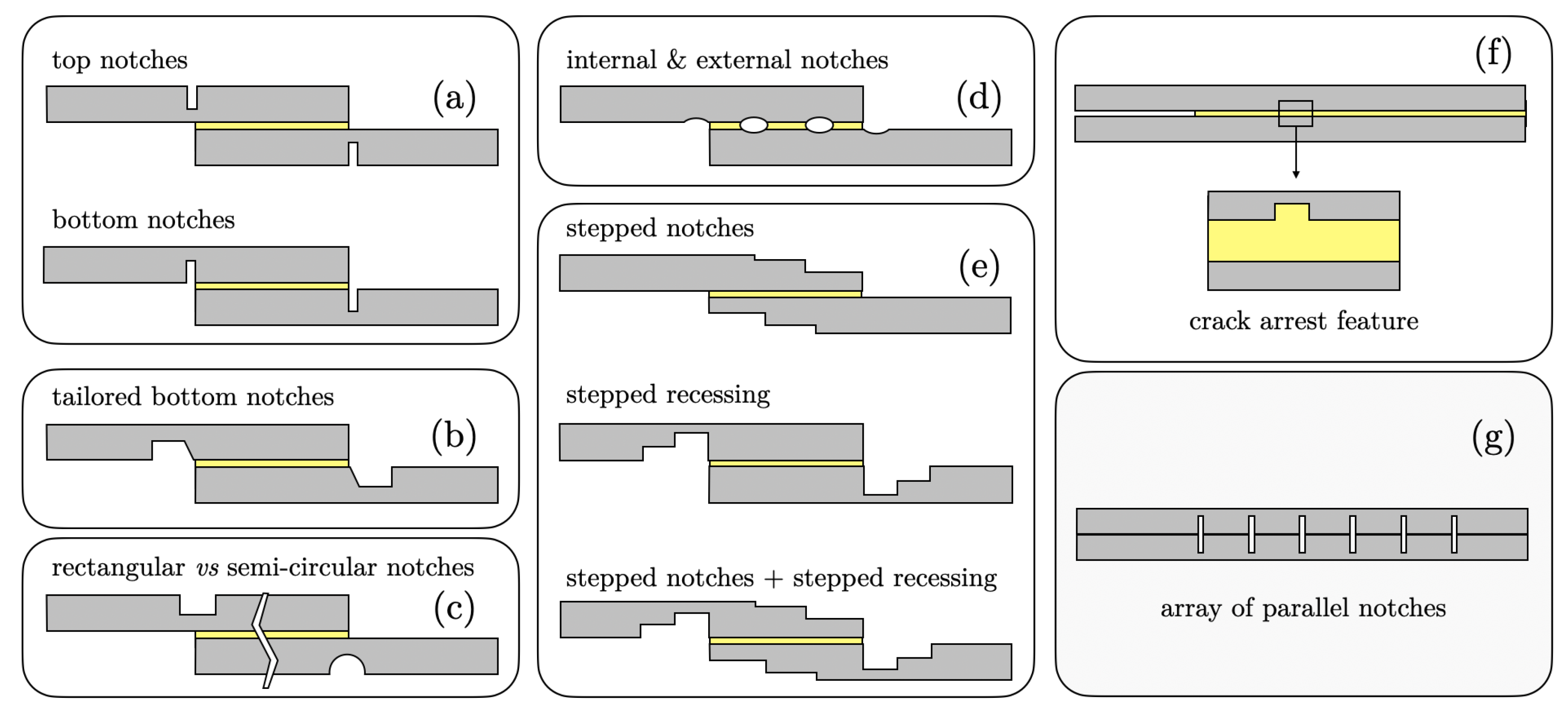
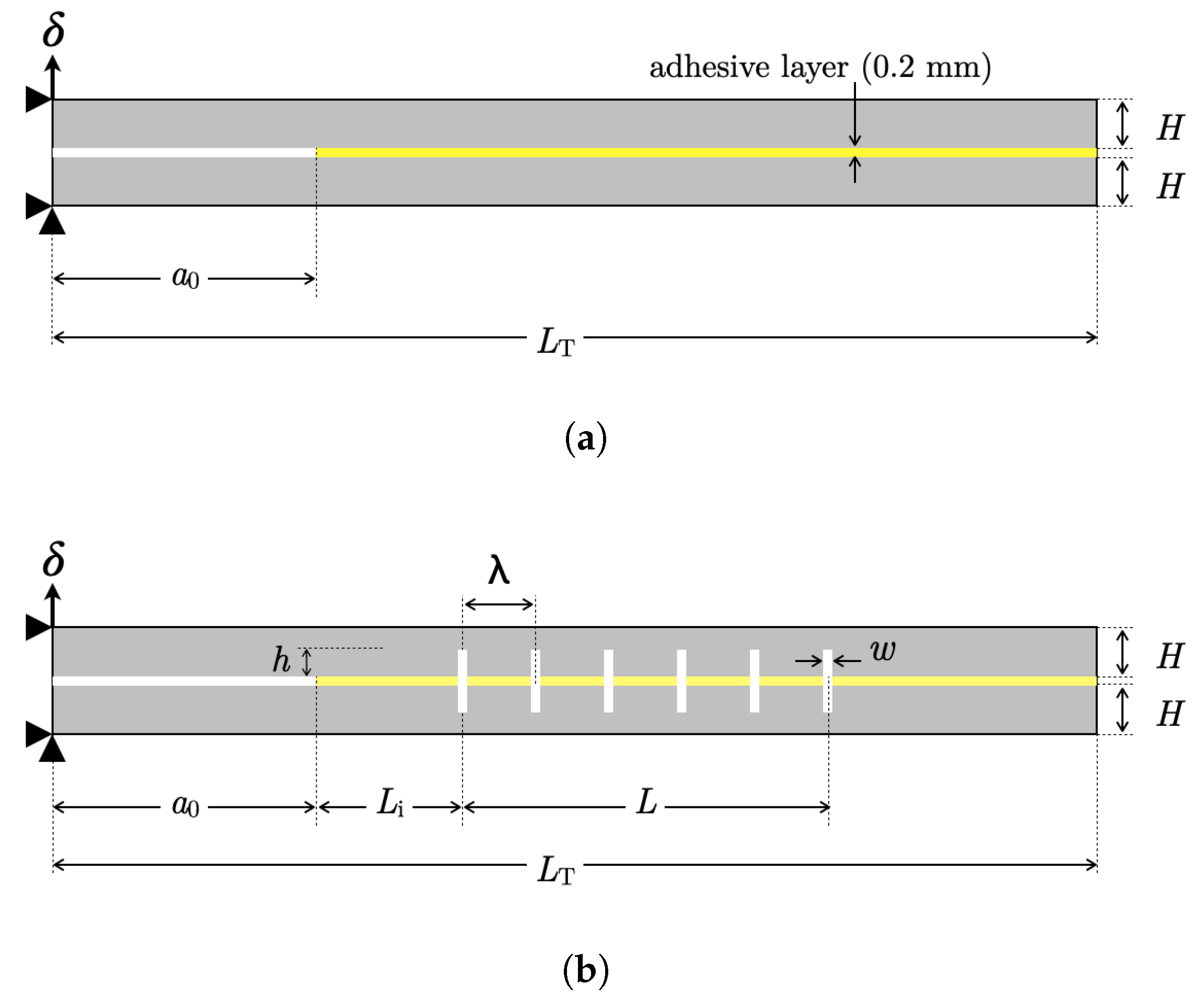
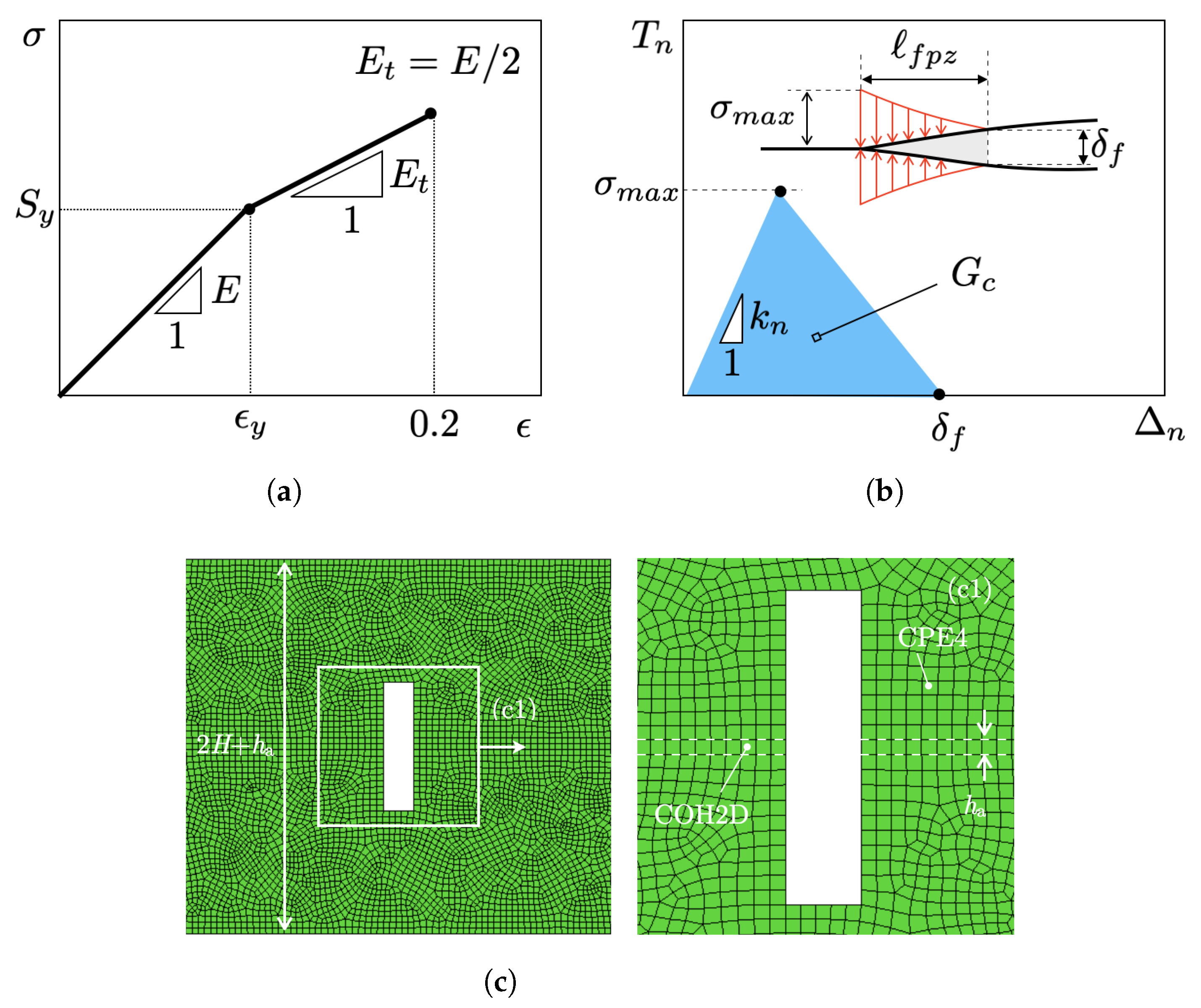
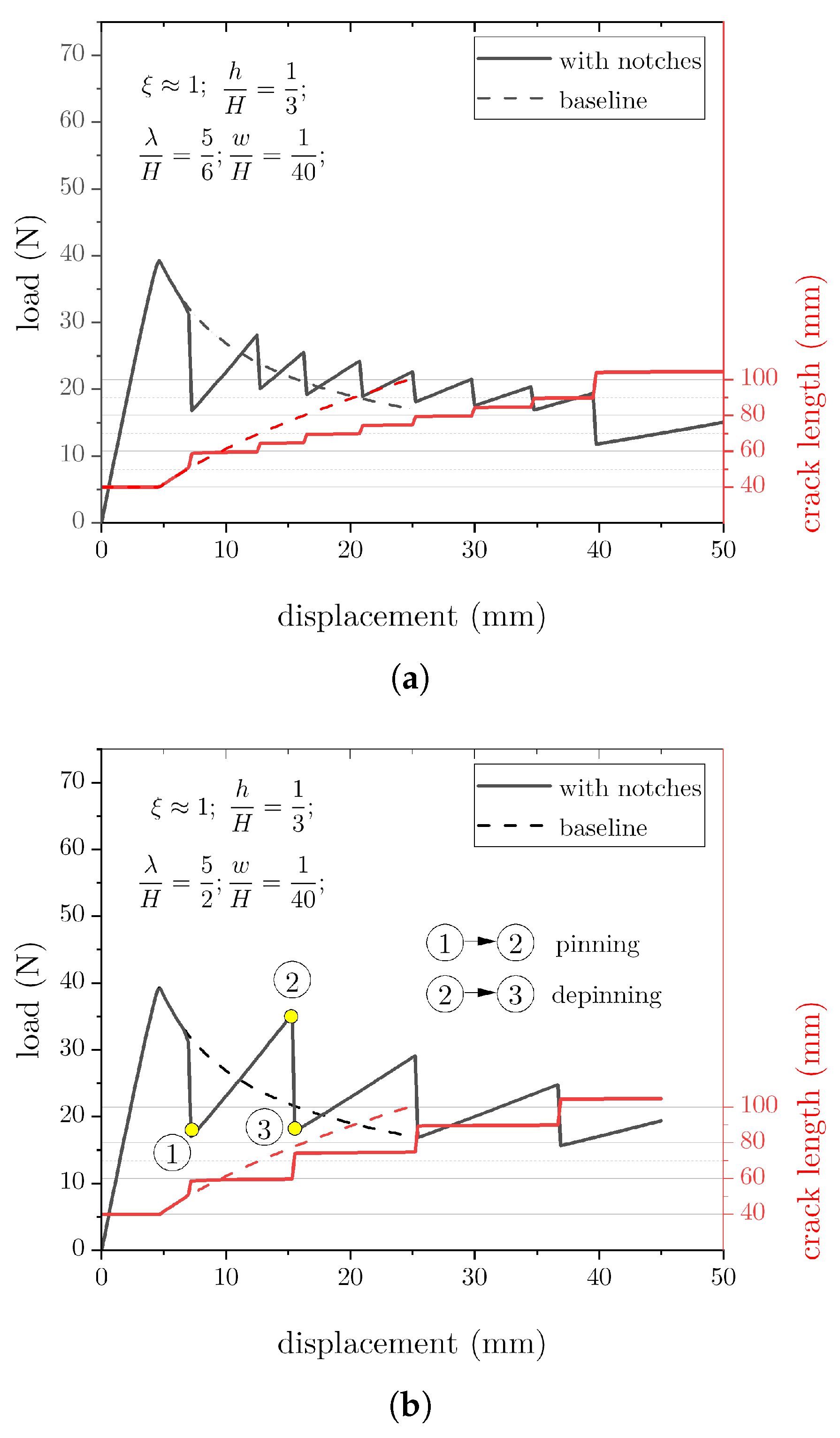
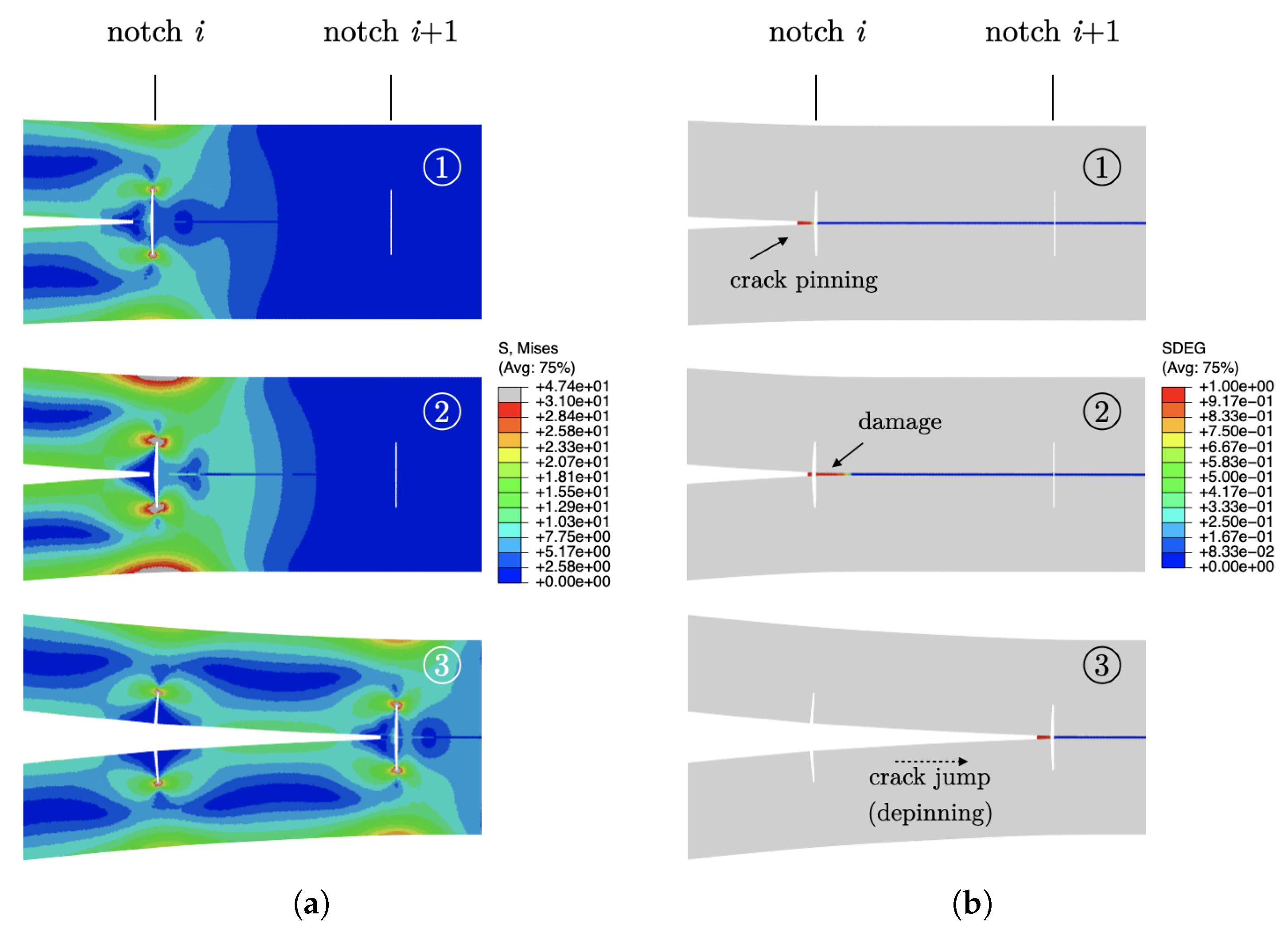
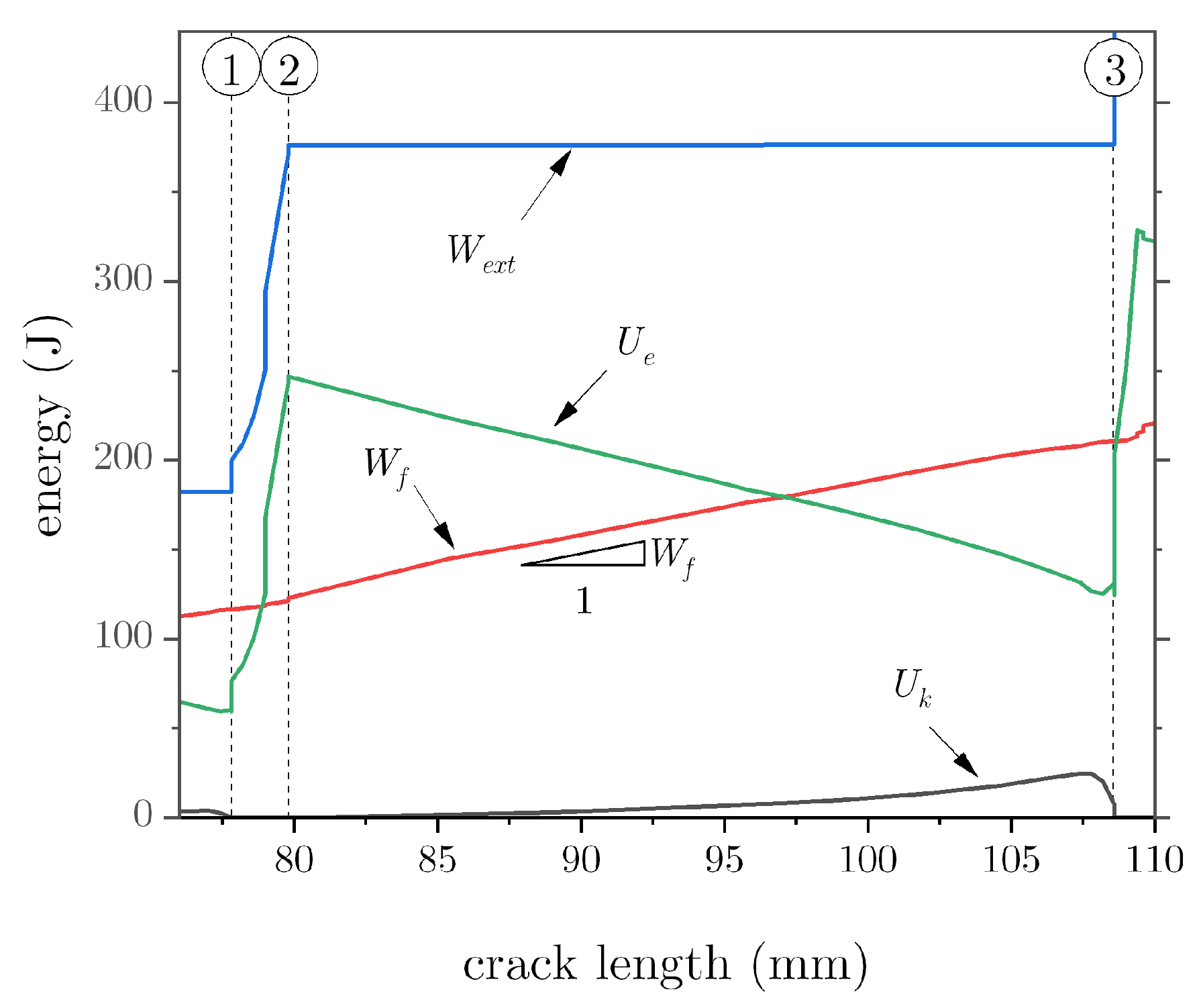


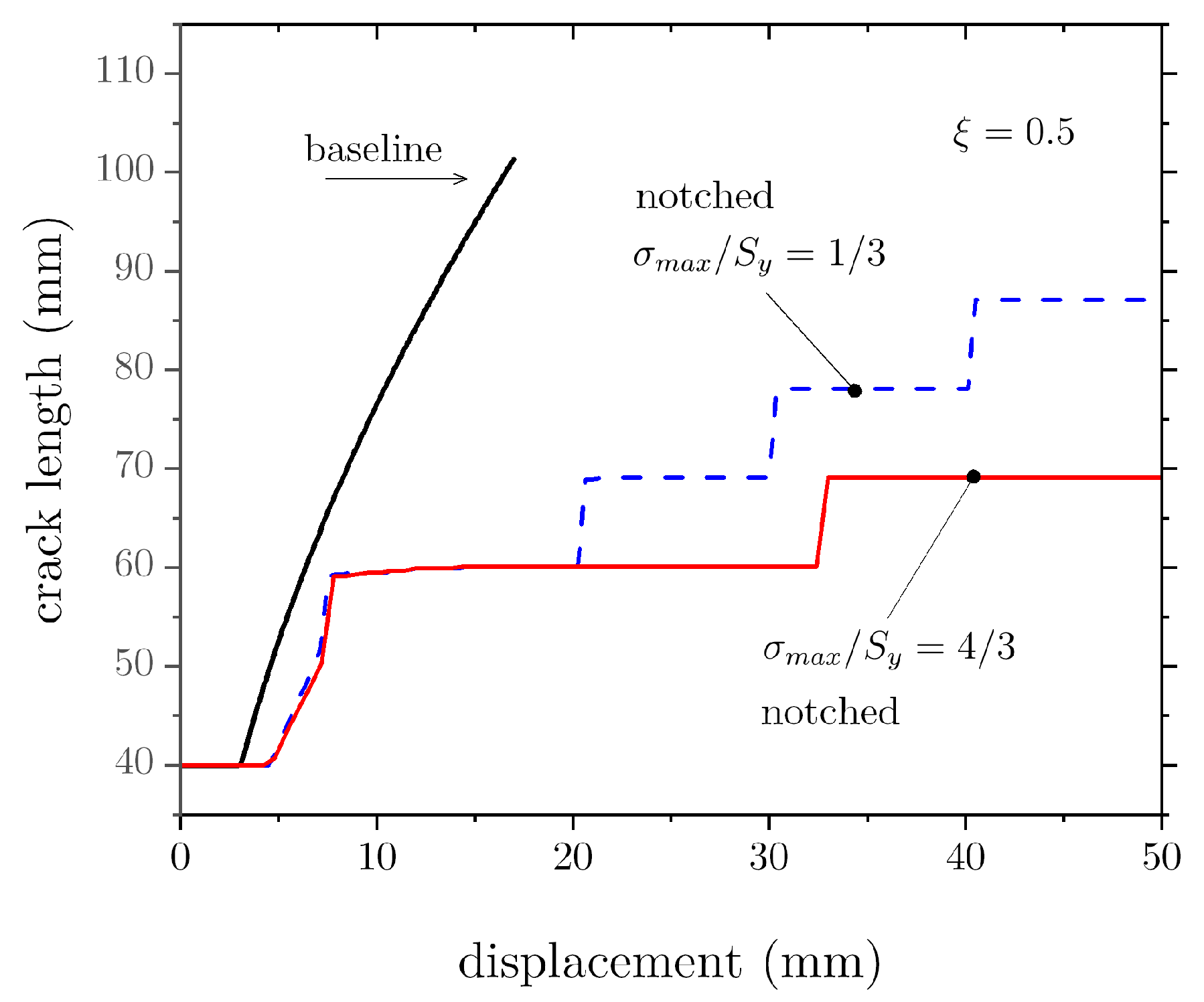
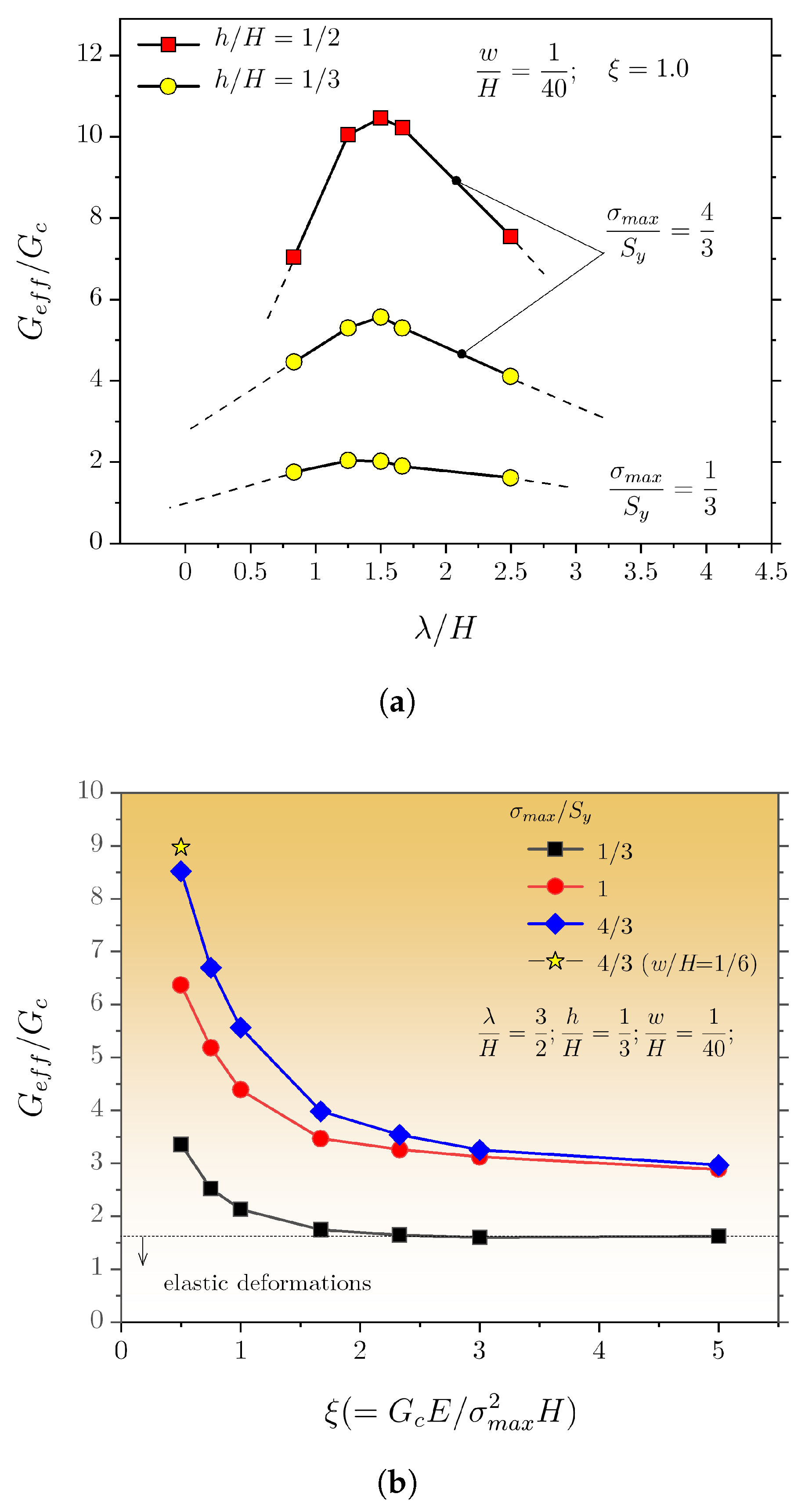
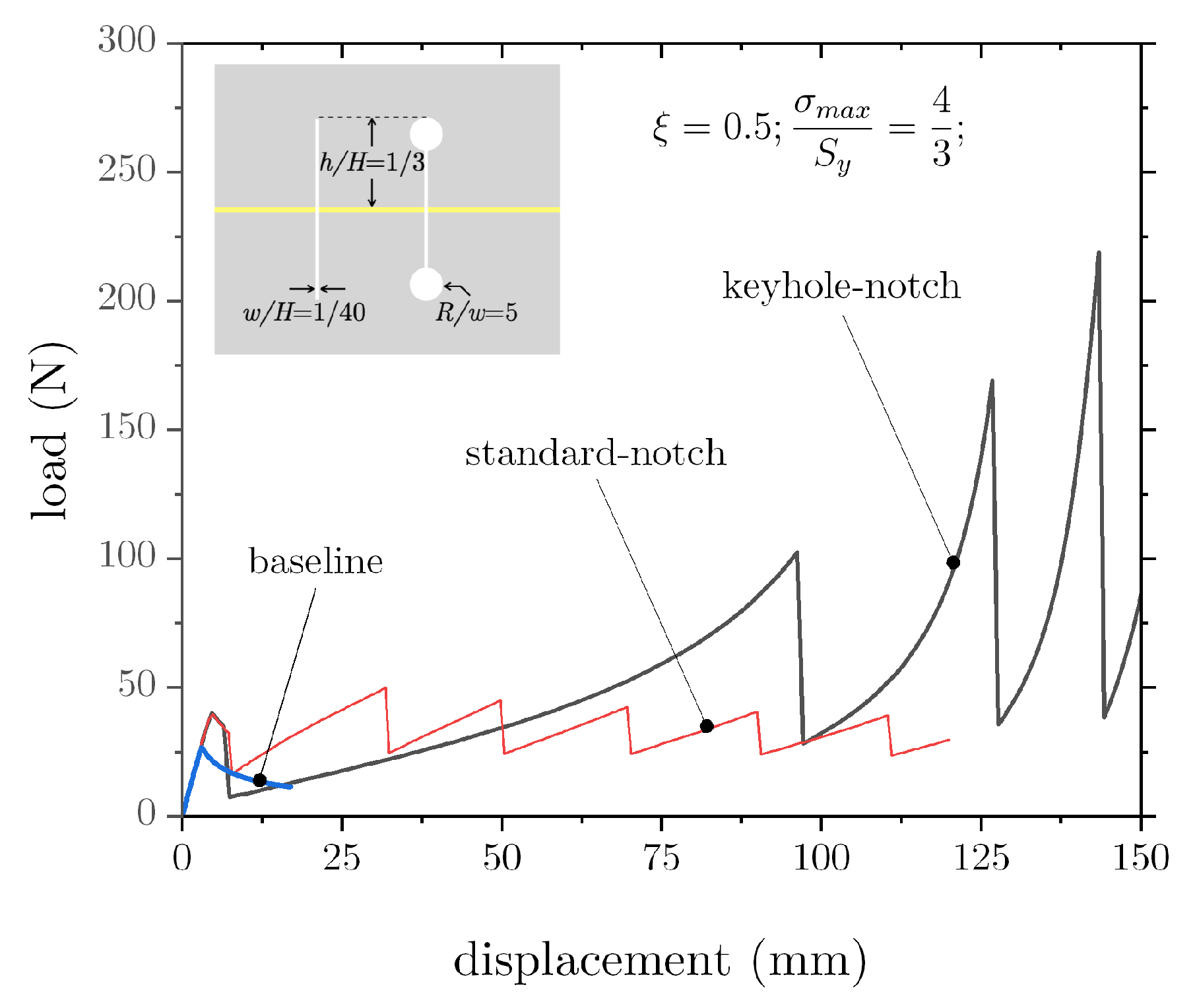
Disclaimer/Publisher’s Note: The statements, opinions and data contained in all publications are solely those of the individual author(s) and contributor(s) and not of MDPI and/or the editor(s). MDPI and/or the editor(s) disclaim responsibility for any injury to people or property resulting from any ideas, methods, instructions or products referred to in the content. |
© 2022 by the authors. Licensee MDPI, Basel, Switzerland. This article is an open access article distributed under the terms and conditions of the Creative Commons Attribution (CC BY) license (https://creativecommons.org/licenses/by/4.0/).
Share and Cite
Qureshi, A.; Guan, T.; Alfano, M. Finite Element Analysis of Crack Propagation in Adhesive Joints with Notched Adherends. Materials 2023, 16, 391. https://doi.org/10.3390/ma16010391
Qureshi A, Guan T, Alfano M. Finite Element Analysis of Crack Propagation in Adhesive Joints with Notched Adherends. Materials. 2023; 16(1):391. https://doi.org/10.3390/ma16010391
Chicago/Turabian StyleQureshi, Ayman, Tianyue Guan, and Marco Alfano. 2023. "Finite Element Analysis of Crack Propagation in Adhesive Joints with Notched Adherends" Materials 16, no. 1: 391. https://doi.org/10.3390/ma16010391






